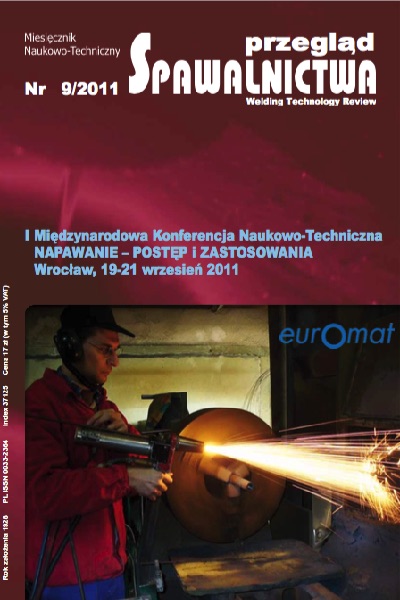Laserauftragschweißen
Main Article Content
Abstract
Extreme requirements for machinery and equipment make that modern materials can be used in a very narrow range of applications. Although there are many surfacing methods, their practical application is not yet widespread. There is often lack of adequate knowledge related to the technique and it limitations, the cost of application and properties. The choice of method depends on the coating requirements for a particular part and the working conditions of it. The high-power lasers are used for surfacing by welding of different coating materials and substrates with very different properties. Particularly important is the fact that lasers are characterized by a simple process automation, operation and service
Napawanie laserowe
Ekstremalne wymagania stawiane elementom maszyn i urządzeń powodują, że nowoczesne materiały mogą być stosowane w bardzo wąskim zakresie. Chociaż istnieje wiele metod nakładania powłok, praktyczne ich zastosowanie nie jest jeszcze powszechne. Często brakuje odpowiedniej wiedzy na temat danej techniki i jej ograniczeń, kosztów stosowania oraz szeroko rozumianych właściwości stosowanych materiałów powłokowych. Wybór metody nakładania powłoki zależy od wymagań stawianych określonemu elementowi oraz warunków pracy tego elementu. Obecne na rynku lasery dużej mocy umożliwiają napawanie powłok z różnych materiałów i na podłoża o bardzo różnych właściwościach. Szczególnie istotne jest to, że urządzenia laserowe charakteryzują się łatwą automatyzacją procesu, prostą obsługą i serwisem.
Downloads
Article Details
Creative Commons CC BY 4.0 https://creativecommons.org/licenses/by/4.0/
Welding Technology Review (WTR) articles are published open access under a CC BY licence (Creative Commons Attribution 4.0 International licence). The CC BY licence is the most open licence available and considered the industry 'gold standard' for open access; it is also preferred by many funders. This licence allows readers to copy and redistribute the material in any medium or format, and to alter, transform, or build upon the material, including for commercial use, providing the original author is credited.
References
E. Beyer: Survey of Laser Hybrid Processes; Tagungsband Lasers in Manufacturing 2001; München; Seite 404-415; Juni 2001.
B. Brenner; V. Fux; A. Wetzig: Induktiv unterstütztes Laserauftragschweißen; Härterei-technische Mitteilungen; Heft 52; Band 4; Seite 221-225: 1997.
H. Hügel: Strahlwerkzeug Laser eine Einführung; BG Teubner; Stuttgart; 1992.
Lehrstuhl für Lasertechnik der RWTH Aachen; Lehrunterlagen zur Vorlesung Lasertechnik I + II auf CD; Stand 1998
S. Nowotnyetal;Hybrid techniques and highest precision in laser cladding; in LaserOpto 33.2001; Seite 57-60; 2001.
K. Partes; C. Theiler; T. Seefeld; F. Vollertsen: Laser cladding powered by diode lasers at high processing speed; in Tagungsband 2nd International WLT-Conference on Lasers in Manufacturing; Seite 51-55; 2003.
H. Stiele; B. Brenner; Induktiv unterstützte Laser-Materialbearbeitung; Stahl 2001; Band 6; Seite 49-51; 2001.
R. Volz: Optimiertes Beschichten von Gusseisen-, Aluminium- und Kupfergrundwerkstoffen mit Lasern; Dissertation Universität Stuttgart; Teubner-Verlag; Stuttgart; 1998, auf. lt werden.
